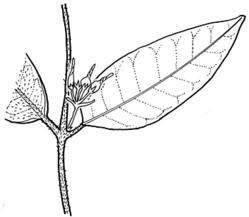Melodinus acutiflorus F.Muell. APNI* Synonyms: Melodinus gratus S.Moore APNI*
Melodinus guilfoylei F.Muell. APNI*
Melodinus australis Maiden & Betche APNI*

Description: Tall climber, branchlets pubescent.
Leaves lanceolate to ± oblong-elliptic or elliptic, mostly 4–10 cm long, 15–30 mm wide, apex shortly acute or acuminate, lower surface finely and softly pubescent; petiole c. 5 mm long.
Flowers scented, mostly 3 or 5 on each axillary peduncle. Calyx lobes narrow, acute, c. 3 mm long, pubescent. Corolla white or creamy; lobes linear, 6–7 mm long, acute; scales absent at throat.
Berry globose, 3–4 cm diam., red to purplish.
Flowering: spring–autumn.
Distribution and occurrence: Grows in subtropical rainforest, north from Mt Lindesay and Toonumbar (upper Richmond R. district).
NSW subdivisions: NC
Other Australian states: Qld
Melodinus australis Maiden & Betche, given here in synonymy, is an illegitimate name, because the name M. acutiflorus F.Muell. has priority. The name Melodinus australis Maiden & Betch should not be confused with Melodinus australis (F.Muell.) Pierre, which is a different species. K.L.Gibbons 24 June 2020.
Text by G. J. Harden & J. B. Williams
Taxon concept: Flora of NSW 3 (1992)
APNI* Provides a link to the Australian Plant Name Index (hosted by the Australian National Botanic Gardens) for comprehensive bibliographic data
***The AVH map option provides a detailed interactive Australia wide distribution map drawn from collections held by all major Australian herbaria participating in the Australian Virtual Herbarium project.
|


